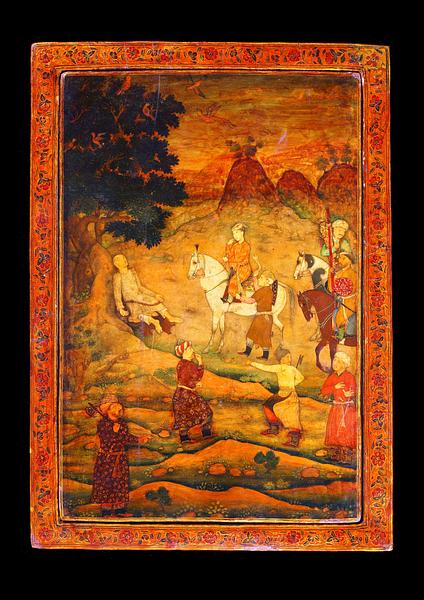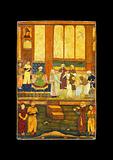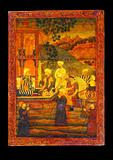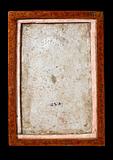A mirror case with three paintings from a manuscript of Sadi’s Gulistan
India, Mughal; the paintings: c. 1610-1615
The mirror: c. 1640
Mirror case: 21.3 × 15.2 cm
In around 1610-1615, a copy of the Persian poet Sadi’s Gulistan (Rose Garden) was made for the Great Mughal Jahangir. The narrow miniatures were painted by the best of the court studio’s artists. The manuscript was split up during the reign of Shah Jahan. Three of the paintings were transferred to this mirror case, while others are found today at the Walters Art Museum in Baltimore.
The painting that shows “A Young Man Expires When he Sees the Prince he Loves” was signed by Balchand. John Seyller has attributed “A Vizier Persuading a Prince to Spare the Life of a Young Thief” to Abu’l Hasan, and “A Prince Visiting a Dervish who has Abandoned his Former Way of Life” to Abid.
When the narrow paintings were transferred to the mirror case in around 1640, additions were made to them at both the top and the bottom by one of Shah Jahan’s artists, who Seyller has identified as Murar. The quality of the additions is high, but upon closer inspection one realizes that it does not equal that of the earlier paintings.
The mirror case is one of the finest extant examples of lacquerwork from 17th-century India.
Inv. no. 1/2009
Published in:
Drouot-Richelieu, Paris, 8/12-1978, lot 117;
John Seyller: “Two Mughal mirror cases” in Journal of the David Collection, 3, 2010, pp. 130-159;
John Guy and Jorrit Britschgi: Wonder of the age: master painters of India, 1100-1900, Metropolitan Museum of Art, New York 2011, cat.no. 39;
John Seyller: “Balchand” in Milo C. Beach, Eberhard Fischer, B. N. Goswamy (eds.): Masters of Indian painting, vol. 1, 1100-1650, Zûrich.2011, cat.no. 6, fig. 8;
Kjeld von Folsach, Joachim Meyer: The Human Figure in Islamic Art – Holy Men, Princes, and Commoners, The David Collection, Copenhagen 2017, cat.no. 60;




